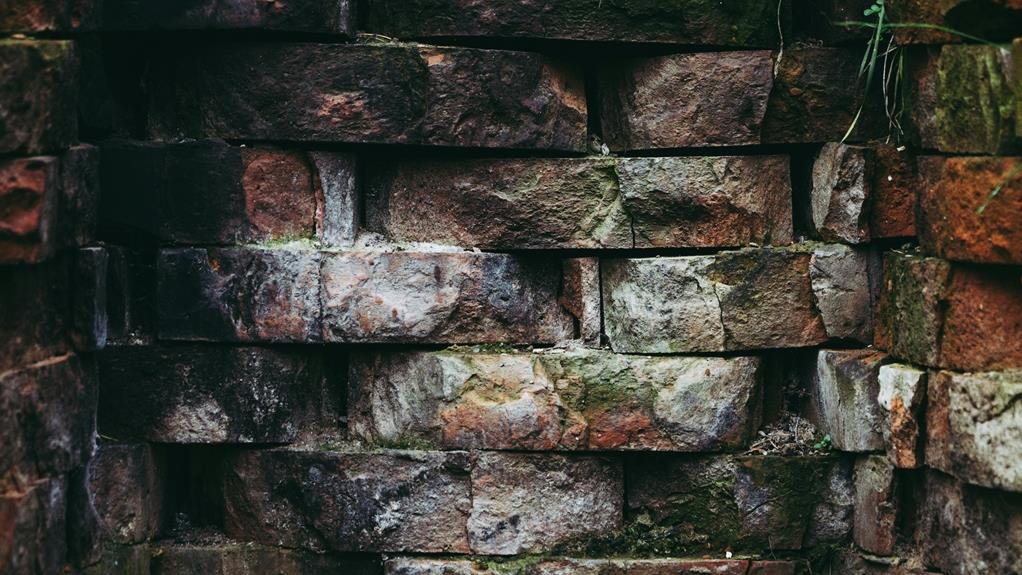At Guelph Concrete LTD, we understand the challenges of maintaining the beauty of your interlocking brick surfaces in Guelph, Ontario. With over 15 years of experience, we’ve perfected the best methods to effectively remove moss from between your bricks.
First, we recommend scraping away the moss using a flathead screwdriver and sweeping the debris with a stiff-bristle broom. Afterward, applying a safe weed-killer solution and thoroughly rinsing the area will help ensure the moss doesn’t return.
For a more comprehensive clean, use a pressure washer set to 1,500 PSI, holding the nozzle six inches away from the surface to avoid any damage.
Once the area is clean, sweeping fresh joint sand between the bricks will help maintain their integrity. Regular maintenance, such as using a 10-15% bleach solution and keeping the surface dry, will also prevent moss regrowth.
For long-term solutions and professional assistance, contact Guelph Concrete LTD. We’re here to help you preserve the appeal of your outdoor space. Call us today for a free estimate at 548-490-2074.
Scrape Away Moss or Weeds
Let’s start by using a flathead screwdriver to carefully scrape away the moss or weeds from between the interlocking bricks. We need to be gentle to avoid damaging the bricks themselves. Carefully work the screwdriver along the edges of the bricks, lifting and dislodging the moss or weeds.
By doing this, we’re not just cleaning up the appearance but also focusing on moss prevention, which is pivotal for long-term interlock maintenance.
After we’ve scraped away the bulk of the moss or weeds, it’s time to grab a stiff-bristle broom. Sweep away the dislodged bits, ensuring no debris is left behind. This step is necessary because any remaining organic material can quickly lead to new growth, undoing our hard work.
Once we’ve cleared the area with the broom, we should rinse the interlocking bricks with water. A simple garden hose will do. This rinse helps to wash away any remaining particles and gives us a clear view of the cleaned surface.
Use Weed-Killer Solution

Applying a weed-killer solution directly onto the moss between the interlocking bricks is our next step to ensure thorough removal. First, we need to select a solution that’s safe for interlocking bricks. There are many eco-friendly options available, which are perfect for our DIY moss removal project. Let’s pick one that aligns with our values of sustainability and moss prevention.
Once we’ve our chosen weed-killer, we’ll carefully apply it to the moss-infested areas. It’s important to target only the moss, avoiding overspray onto the bricks to prevent any potential damage. We can use a spray bottle for precise application, ensuring the solution reaches deep into the moss.
After applying the weed-killer, we should allow it ample time to work its magic. Typically, a few hours or as per the product instructions should suffice. During this period, the solution will penetrate and break down the moss structure.
If the moss persists, we might need to repeat the application. Patience is key here—making sure we’ve completely eliminated the moss growth is essential for long-term moss prevention.
Pressure Wash Pavers
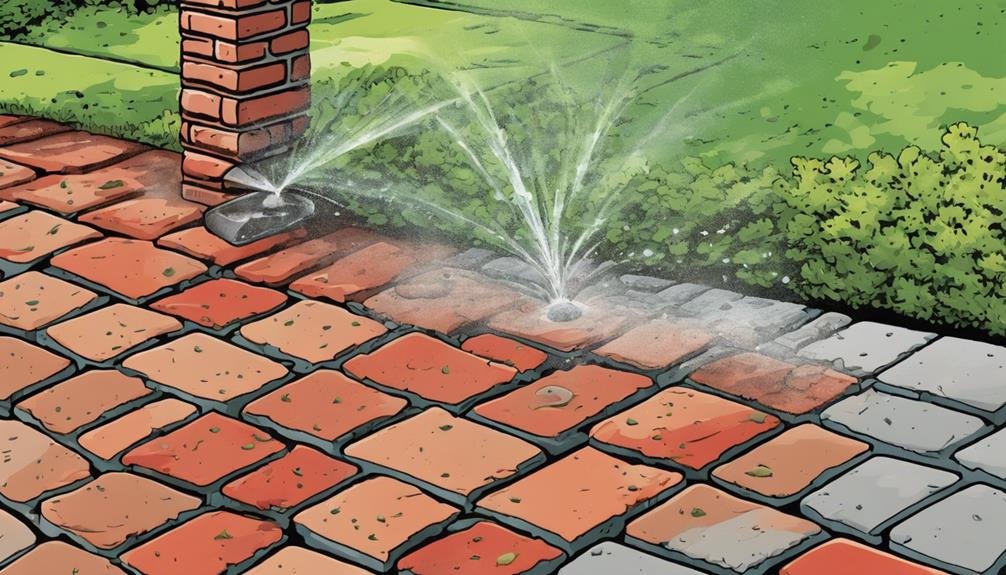
To effectively eliminate moss between our interlocking bricks, we should start by pressure washing the pavers with a washer set to a safe 1,500 pounds per square inch (PSI). This guarantees we achieve thorough surface cleaning without damaging the pavers.
First, let’s gather our equipment and safety gear, then follow these steps:
- Preparation: Clear any loose debris from the area.
- Set Up: Attach the pressure washer to a water source and set the water pressure to 1,500 pounds per square inch (PSI).
- Washing: Hold the nozzle at least 6 inches away from the pavers to avoid displacing joint sand or sealant. Move the nozzle in a sweeping motion to evenly clean the surface.
- Inspection: After washing, check for any areas that might need additional attention.
- Final Touch: Once dry, sweep in fresh joint sand to maintain the integrity of the interlocking bricks.
Here’s a visual guide to help us:
| Step | Action | Key Points |
|---|---|---|
| Preparation | Clear debris | Ensure a tidy starting surface |
| Set Up | Attach washer, set to 1,500 pounds per square inch (PSI) | Optimal water pressure |
| Washing | Sweep motion, 6-inch distance | Prevent harm |
| Inspection | Check cleaned area | Spot additional moss |
| Final Touch | Sweep in joint sand | Preserve integrity |
Prevent Weed Growth

Preventing weed growth between our interlocking bricks starts with using polymeric sand, which creates a strong barrier against unwanted plants. We begin by thoroughly cleaning the spaces between the bricks to remove any existing weeds and debris. Proper soil preparation is key; we need a clean, weed-free base to guarantee the polymeric sand adheres well.
Next, we follow the manufacturer’s instructions for installing polymeric sand. It’s essential to apply the sand evenly and confirm it fills all the gaps. Once applied, we use a compactor to settle the sand and then lightly mist it with water to activate the binding agents. This process forms a solid barrier, effectively preventing weed growth.
Regular maintenance is crucial. We should inspect the joints periodically, especially after heavy rains or seasonal changes, and replace any displaced sand to maintain its weed-prevention effectiveness.
In addition to using polymeric sand, adopting mulching techniques around the perimeter and ensuring proper plant spacing can help minimize weed infiltration. Mulch acts as a secondary barrier, and appropriate spacing reduces the chances of weeds spreading into the brick joints.
Remove Moss With Chemicals
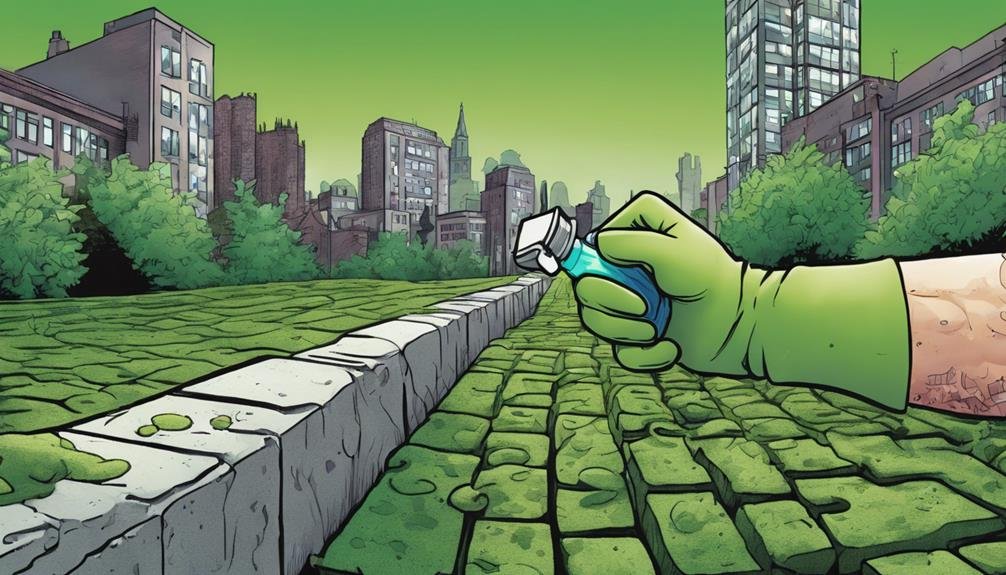
We can effectively eliminate moss between our interlocking bricks by using commercial chemical solutions designed for this purpose. To get started, it’s essential that we follow the manufacturer’s instructions closely to guarantee both safety and effectiveness.
First, we should test the chemical solution on a small, inconspicuous area to avoid any potential damage to our bricks. After confirming it’s safe, we can proceed with the full application.
To make sure we’re thorough and efficient, let’s keep these key steps in mind:
- Read and adhere to the manufacturer’s instructions.
- Test on a small area first.
- Rinse thoroughly with water after treatment.
- Consider a pressure washer to remove dead moss and residue.
Once we’ve applied the solution, it’s important to rinse the treated area thoroughly with water to prevent any lingering chemicals from harming our landscape. A pressure washer can be a great tool to help remove any dead moss and leftover residue, ensuring a clean finish.
For those of us who are environmentally conscious, there are also some eco-friendly alternatives available that can help with moss prevention without harsh chemicals.
Regular Maintenance Tips
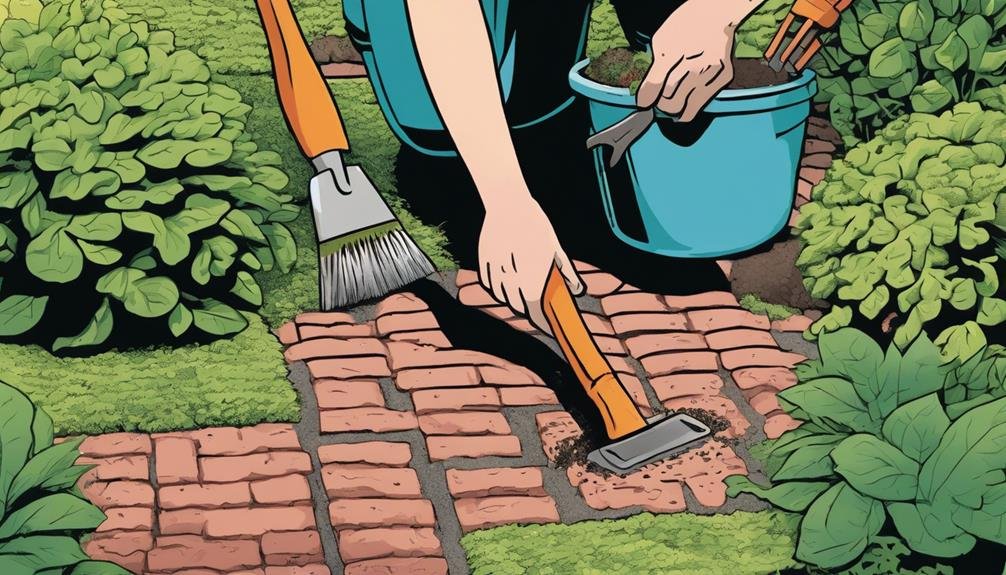
After removing moss with chemicals, we should establish a regular maintenance routine to keep our interlocking bricks looking their best. Regular sweeping or blowing away debris is our first line of defense. This simple task helps with moss prevention by ensuring organic matter doesn’t accumulate and create a welcoming environment for moss.
Next, let’s discuss a deeper clean. Every few months, applying a 10-15% bleach solution can be an effective maintenance method. Make sure to rinse the area thoroughly with fresh water afterward to remove any lingering moss and bleach residue. Remember, keeping the surface dry is important to minimize damage to the jointing sand and prevent moss regrowth.
While cleaning, it’s important to be gentle to avoid disturbing the joint sand. The integrity of our interlocking bricks relies on this sand to stay in place and keep everything stable. Therefore, using a soft-bristle broom or gentle water spray can be helpful.
Professional Assistance
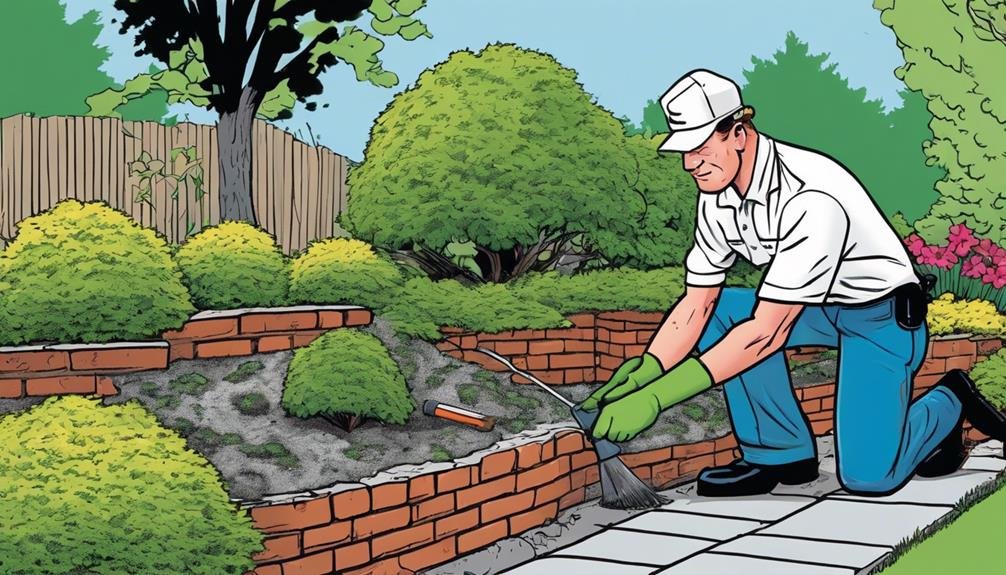
For those times when our DIY efforts aren’t sufficient, seeking professional help can be the key to effectively eliminating moss from between our interlocking bricks. In Guelph, Ontario, specialized services are available to handle this task, evaluating our outdoor spaces to keep them pristine.
Professionals bring a wealth of expertise to the table. They start by gauging the extent of moss growth and then recommend tailored solutions that suit our specific needs. This approach ensures that the removal process is both effective and gentle on our interlocking bricks. Additionally, experts are well-versed in using the right tools and techniques to eradicate moss without causing any damage.
Here’s why professional help can be a game-changer:
- Thorough Removal: Guarantees all moss is effectively eliminated.
- Damage Prevention: Utilizes appropriate methods to safeguard our bricks.
- Hassle-Free: Saves us time and effort.
- Environmental Impact: Utilizes eco-friendly solutions when applicable.
Frequently Asked Questions
How to Get Rid of Moss Between Interlocking Bricks?
Let’s tackle moss prevention and weed removal together! We can try natural remedies like baking soda or soda crystals, and if that doesn’t work, consider pressure washing. Regular maintenance is key to keeping those bricks moss-free.
What Keeps Moss From Growing Between Pavers?
To keep moss from growing between pavers, we should focus on preventive measures and moisture control. Natural solutions like baking soda can help. Regular cleaning, proper drainage, and ensuring sunlight exposure are key steps to maintain pavers.
Does Vinegar Kill Moss Between Pavers?
Yes, vinegar is effective for killing moss between pavers. We mix vinegar and water in a 1:1 ratio, apply it to mossy areas, and let it sit for 30 minutes before rinsing. It’s an eco-friendly alternative!
How Do You Get Rid of Moss Between Block Paving?
Did you know 75% of homeowners find pressure washing effective? Let’s use it along with weed killer, or try natural remedies like soda crystals. For stubborn moss, consider professional cleaning. Regular maintenance keeps our block paving looking great!
Conclusion
At Guelph Concrete LTD, we’ve been helping our community maintain beautiful outdoor spaces for over 15 years. In the battle against moss between your interlocking bricks, we’ve a clear path forward. By scraping away the moss, using a weed-killer, and pressure washing, we can help you reclaim your outdoor space.
Preventative measures and regular maintenance are key, much like a well-tended garden in a Jane Austen novel.
If this feels overwhelming, professional help is always an option. Our experienced team at Guelph Concrete LTD is ready to assist you in keeping your patios pristine and inviting, perfect for those warm Guelph summers.
Contact us today for a free estimate at 548-490-2074. Together, we can ensure your outdoor areas remain beautiful and moss-free.


